As a USC student I am generally skeptical of everything I encounter in life. Whether ultimately good or bad, this means I do not take anything at face value (especially after this class). I think it is important to enter every museum with this mentality. The Getty Villa is famous for its Villa dei Papiri inspired architecture and carefully manicured gardens. It is also infamous for its history of scandalous acquirement of artifacts, though I doubt the general public is aware of this ignominious past. In fact, before the resource presentation on Monday, I was completely unaware of its questionable and messy history, which further illustrates my cynicism. After an in depth analysis of the museum’s collection, the question at large remains: What can we take away from a museum that was born as a tax write off?
I would first like to touch upon some interesting and I think very important points that were made in class discussions this past week and then I will examine some specific pieces in the museum. It could be argued that the complicity of the museum begins even before you walk in. The design of the entrance is intentional. It is supposed to imitate the process of walking into an archaeological dig. Was this done to lend more credence to the artifacts that visitors may enjoy once they complete the inane ascension and subsequent declension into the museum’s main grounds? One could assume so. But what does this analogy say about the abundance of artifacts with no known provenance? Furthermore, while we are on the subject of archaeological digs, wouldn’t it make sense to further emulate a dig site by arranging the museum in a stratigraphic manner? Digs are usually sorted by general context, chronology, and interrelationships. However, the Getty Villa’s organization of their collection appears more haphazard and somewhat thoughtless. Is its thematic organization targeted towards the masses in an effort to make the material more digestible? The objects that are in the collection are at the whim of the collector and Jean Paul Getty often chose pieces for their aesthetic quality. The museum’s lack of organization may also stem from the hodgepodge manner in which many of the antiquities were acquired.
On that note, who is the museum targeted for? It seems to me that the answer to this is: the general masses. Is there anything wrong with this? Is it okay for those who have only superficial knowledge of Classics to have a place where they can simply enjoy the “art” and splendor of a period in the distant past? A place where they can feel like they are spending a cultured afternoon? I personally believe that the mentality of only acquiring superficial knowledge is detrimental. What is the point? Whether Classics is your field of study or not you should go to a museum with the intent of extending your knowledge base. You should be encouraged to seek more in depth information. When objects are removed from their contexts they lose their importance and many of the objects are not simply “art.” Visitors may walk by and appreciate the beauty, but they cannot hope to understand the cultures at large. The Villa is illustrative. Its gaudy architecture and lush gardens are supposed to offer an insight into what it would be like to live an aristocratic life. In this sense, the collections are reinforcing the idealization of a time period that is already highly fantasized. Additionally, the representation of women in the collection is weak and though it may be due to the questionable way in which the antiquities were acquired it serves to reanimate and reaffirm the male dominance of the period.
I chose these figures because this room was my favorite in the museum. I think these sculptures are incredibly beautiful (Hey, they inspired Picasso). It was also nice to see a room that has a large female presence and interesting to note the apparent regression of the female’s place in society over time. It seems that there is still so little we know about these cultures and apparently cannot hope to learn much more in the future. It is disheartening to know that all the sites containing Cycladic figurines have been looted and that we will essentially never be able to recover the history of prehistoric women. Have these figures then been reduced to novelty status in museums? Is all that we are left with a guessing game?

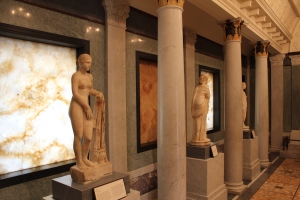
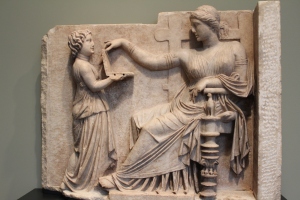
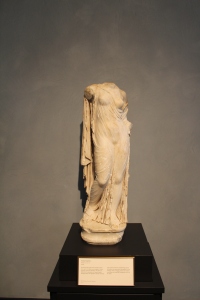

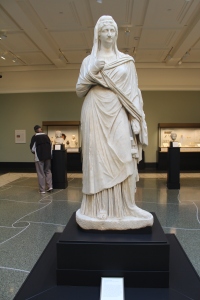
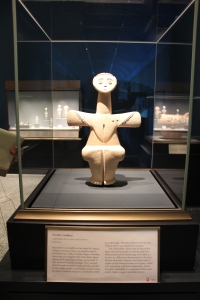

Dear Olivia,
I really enjoy this post. I find your cynicism warranted as I too felt this way. To this point looking back at the Getty Villa’s history, I am stuck on the idea that you should make a film of some kind in order to further expose this great story. Focusing in on the the formation of the museum, a tax write off, and moving into the illegal acquiring of their art collection. I feel that with your interest in the classics and your background in film, you could do an exceptional job in making this a great movie.
Ryan
This is indeed a great story, but an old one.
“I could see the anguish of the intelligentsia… Getty had indulged a Billionaire’s fancy and built himself a sand castle for his old age.” – From “The Getty Museum and the Assyrian Rubber Factory”, in “Jack Smith’s LA”.
Check it out. His essay (and the rest the book) will provide perspective and give you calm, if you let it…